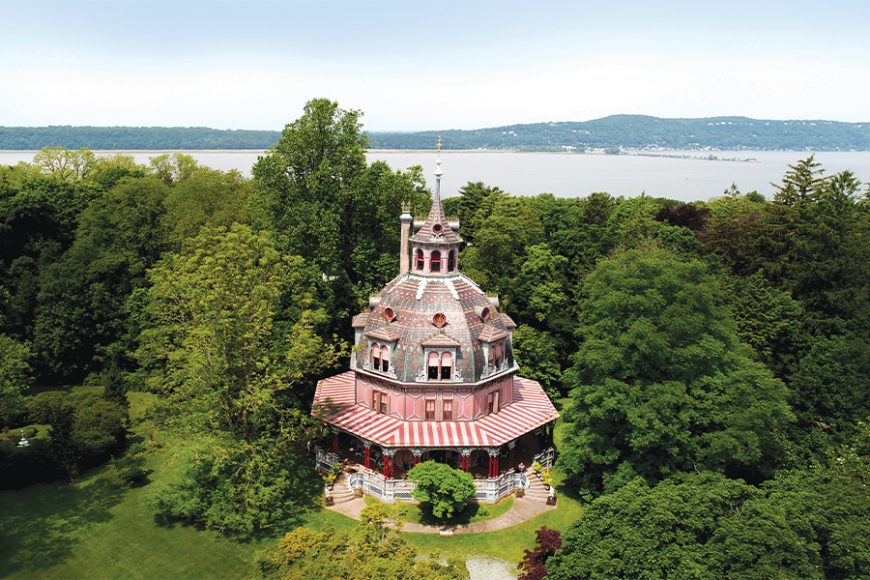Coffee, elopement and a friendly ghost all play their part in the story of the extraordinary Armour-Stiner Octagon House, a private home in Irvington which is now, for the first time, open for guided tours by appointment.
Reached by a narrow path barely big enough for a car to pass, the house magnificently replicates Donato Bramate’s 16th-century Tempietto in Rome and is the only known, fully domed octagonal residence in the world.
I’m two minutes late for the start of the tour and Kelly and Sara, our guides today, are standing on the step, along with six other visitors, waiting to greet me, any tardiness quickly forgiven. Kelly gives a brief introduction to the house and explains how in 19th-century America octagonal houses had become all the rage following the publication of a book, “The Octagon House, A Home for All,” by one Orson Squire Fowler, a phrenologist. She also invites us to take a moment to look at the garden, with its spectacular trees, including a glorious Japanese maple and a rare Kentucky coffee tree, and tells us we are welcome to visit the artist’s studio and small foxglove garden after the house tour is over.
As we step inside, Sara takes over and introduces us, at least figuratively speaking, to Joseph Stiner, who had purchased an earlier iteration of the house in 1872, altering it and adding the dome to create the present structure. Stiner was a successful tea and coffee merchant, who at one time owned up to 60 tea and coffee houses in Manhattan and Brooklyn, an early precursor of Starbucks. He added many whimsical notes to the house he had bought, including tea chests that can still be seen in the second-floor kitchen.
But it was another Joseph whom today’s visitors can thank for the opportunity to see this extraordinary house. Joseph Pell Lombardi, an architect specializing in conservation, restoration and historic preservation the world over, bought the house from the National Trust for Historic Preservation in 1978 in what appears to have been a rare sale. The house was in so much need of restoration that you get the feeling the Trust just wanted to be rid of it.
Lombardi set about restoring the house to its original appearance, with an almost pathological — I use the word advisedly — attention to detail, using microscopic chemical analysis to discover how the house might have looked 150 years ago. He could tell, for instance, where rugs had been placed on the floor from the discoloration in the wooden boards and had new rugs made up in colors and patterns of the period by traditional carpet-makers in Wilton, England. And while we’re talking about home decorating, move over Sherwin-Williams, because Sara tells us how Lombardi used another scientific technique, microscopic paint analysis, to determine which color paint had been used on the original walls, so that the restoration would be fully faithful to the original home.
The octagon shape creates four triangular rooms on each floor, given over to a tea room, pantry, solarium and small library on the first floor. On the higher floors, these relatively small, irregular spaces are used as bathrooms, the original porcelain still intact and working.
And if the joy of the house — apart from its immense whimsy and architectural flourishes — are its first-floor grand salon and dining room, with their original furniture (“cottage” furniture as Sara tells us, which was the IKEA of its day and highly prized) and exquisite china and glass, then the upper floors, with their more intimate rooms and bedrooms are no less thrilling.
Because, above all, this is very much a family home, albeit a family living an extraordinary life in a 19th-century time capsule. Contemporary, framed family photos abound, interspersed between the curios and centuries-old bibelots. “Ignore the toaster and the coffee maker,” admonishes Kelly as we traipse as a group through the second-floor butler’s pantry, with its handsome copper sink and crammed with antique china and silverware, but frankly it’s impossible not to. It’s precisely the juxtaposition of old and new — beautiful old glass and porcelain besides a utilitarian Cuisinart toaster — that gives this remarkable house so much of its charm and character.
One room I especially enjoy is the “ladies’ kitchen,” located on the first floor — not quite the scullery, yet not quite a morning room but somewhere ladies could carry out some of their household duties, checking bills and dabbling in light “hostessing” work. The concept of the lady’s kitchen, interestingly, came about through the works of Harriet Beecher Stowe, who by predicting the end of slavery had inadvertently informed high-born women of the changing order, and alerted them to the fact that soon every woman might have to take care of her household by herself. A salutary moment, you might say.
The Sony TV certainly looks magnificently out of place in the sitting room adjoining the master bedroom. And while the original bells for each room (used to summon staff) are still intact and working and the old telephones have been rewired to make and receive calls, there is something deliciously incongruous when a call comes in during our visit, with its importunate modern ringtone, to be picked up by a disembodied Optimum voice asking the caller to leave a message.
The ghost of a young French girl whose parents had rented the house and who died tragically after running off with a local boy, is said to haunt a room on the third floor, making regular appearances. But she is, by all accounts, a friendly ghost, says Sara, and our small group looks relieved to hear it. The Egyptian Revival Room, opposite — the only remaining room of its kind in America — is one of the most spectacular in the house, with its original furniture, spinet, Egyptian frescoes and David Roberts watercolors. It’s a fitting finale to what has been a jaw-droppingly wonderful visit.
The 45-minute tours are conducted in groups of no more than 20 people and take place Fridays through Mondays, with tickets bookable only in advance. For more, visit armourstiner.com.


